The Best Way to Make Acorn Flour
September 26, 2013 | Updated February 12, 2021
As an Amazon Associate I earn from qualifying purchases.
There is really only one good way to make quality acorn flour: Cold leaching.
Leaching, as is pulling something out. In this case, that something is tannin, which is present in all acorns. Different acorns have different levels of tannins, but in general oaks of the red oak family have more, the white oak family less. One, the Emory oak of the Sonoran Desert, has almost none at all.
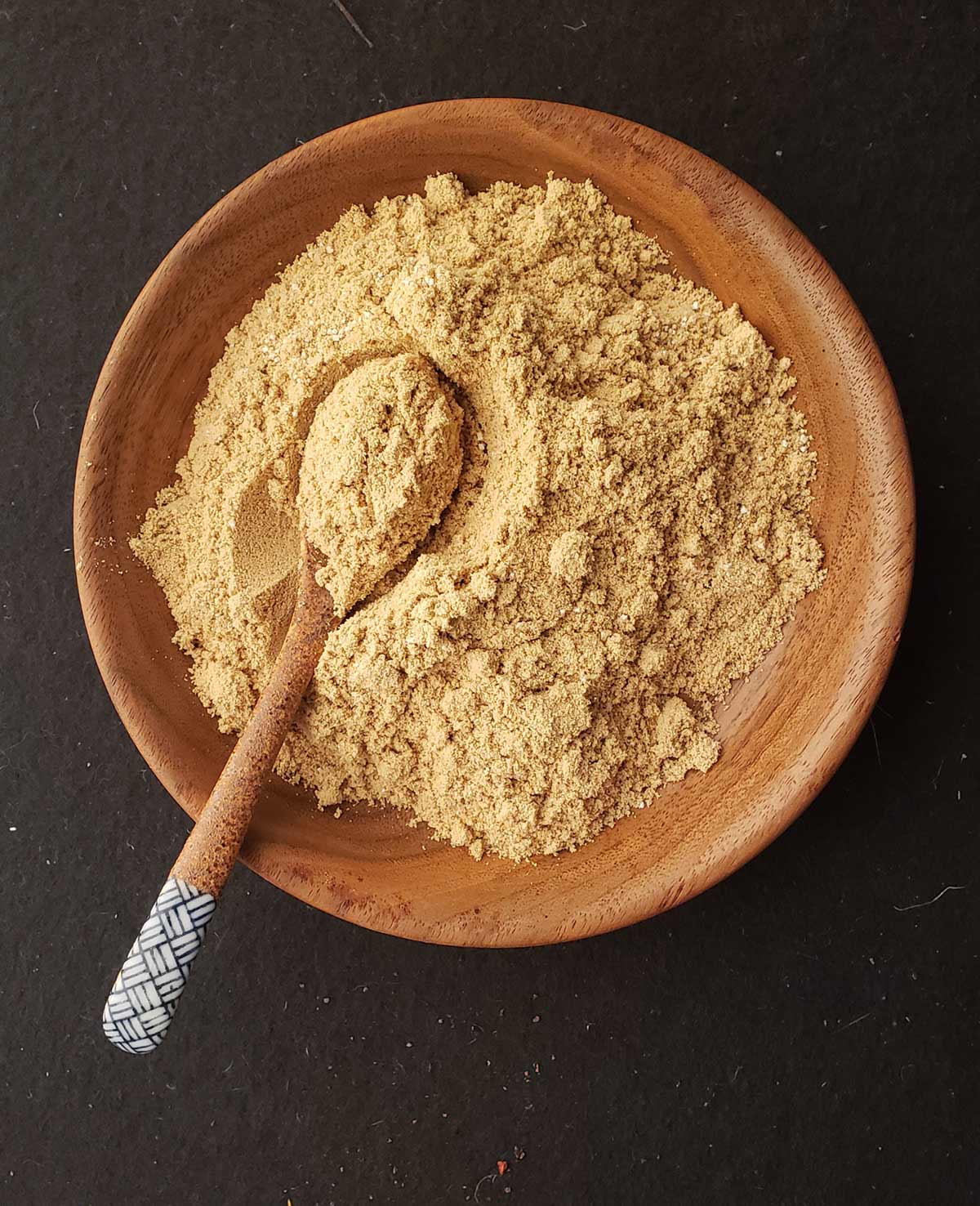
Before I go much further, let me answer the question in many of your minds: Why the heck would I bother making flour from acorns? First, flavor. It’s a lot like chestnut flour: Nutty, a little sweet and just generally interesting. Second, nutrition. Acorns vary in nutrition. Some are very starchy, some oily, a few high in protein. Third, it’s just kinda fun to make something useful and tasty out of something many of us mistakenly believe is poisonous.
In my original post about eating acorns, I recommended the boiling water method of leaching out all those bitter tannins. This works fine, and is comparatively fast; you can have a batch of acorns leached in the time it takes to watch a football game, which is about three hours for those of you who have never actually watched a football game.
The problem? The resulting acorn flour is very dark, and the boiling process destroys a key starch in the acorns — a starch that acts a lot like gluten in wheat, i.e., it helps the acorn flour stick to itself, or to thicken gravy or a roux.
I have found myself using acorn flour mostly for making roux, coating meats or as a flour additive in baked goods, tortillas, and pasta. So that starch is pretty important to me.
Cold leaching solves this problem. It preserves the starches and, when dried properly, keeps the flour lighter — closer to whole wheat than that dark chocolate brown you can get with boiling water-leached flour. The tradeoff is time. It takes at least a few days to “clean” your flour, and it can take more than a week.
But it’s easy time. All you need to do is tend your flour once or twice a day. Here’s how to go about it.
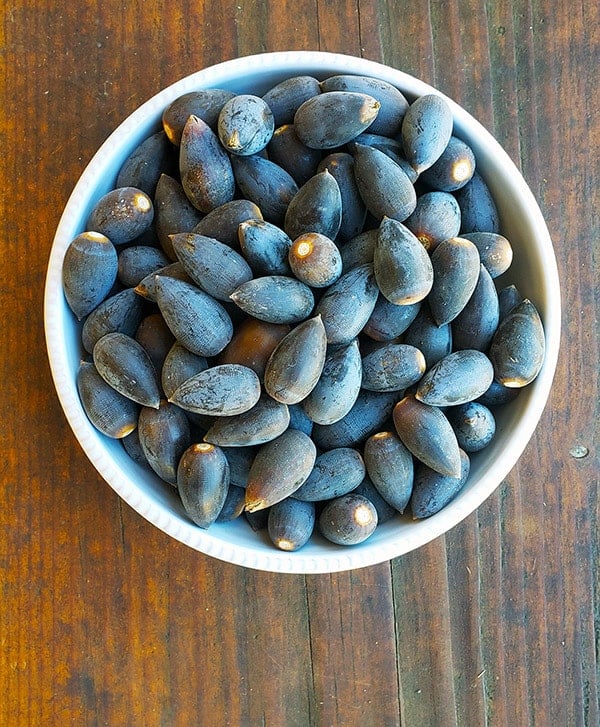
Start with acorns. I know, obvious, right? But know that they need not be fresh. Last summer I made a batch of flour from some red oak acorns I’d picked the previous October. I’d laid them out in a shallow layer in a large tray and just let them dry out. When it came time to crack the shells, it was so much easier than with fresh acorns; fresh acorn shells are pliable, and don’t crack like, say, a hazelnut’s shell.
You will need to soak your shucked acorns in water overnight, though — and it’s the devil to get the papery skins off dried red oak acorns. Those skins darken the flour and are very tannic.
I don’t really bother working too hard at removing the skins, but there is a trick that helps get them off (the skins are called the “test”): Freeze your acorns fresh. When they thaw and you crack them, the skin comes off a lot easier. The problem is storage. Acorns are bulky and can take up a lot of space in your freezer. But hey, if you want that skin off, it will help.
Regardless, shuck your acorns into water. This helps prevent them from oxidizing. I find that if I leave acorn nutmeats out, they turn brown over time. If they are fresh acorns, the papery skins should slip right off once the acorn has soaked a bit.
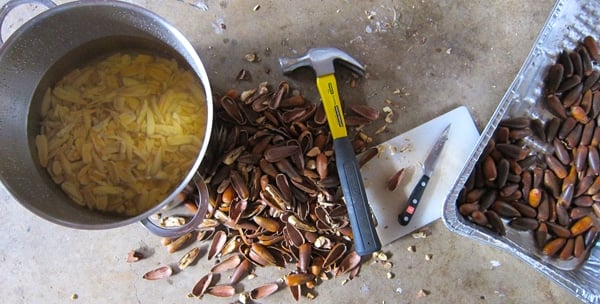
If you have some acorns with worm-eaten bits, you can cut off the bad part if you want to and toss the good part into the bucket of water.
Once your acorns are all shucked, put enough of them to fill a blender or food processor (use a food processor if your blender isn’t too strong) up about 1/3 of the way. Add enough water to fill the bowl of the processor or blender up halfway. Buzz the crap out of it until you get what looks like a coffee milkshake. Play a mean trick on your friends by pouring them some, and watch the hilarity.
Now, you will need a large container. The absolute perfect container to my mind are those big glass jars you get at the Asian market to make kimchi. You can buy gallon glass jars online or in many hardware stores for about $15. Pour the “coffee milk shake” into the big jar and keep adding more until you have about 50 percent ground acorns and 50 percent water. Cap the jar.
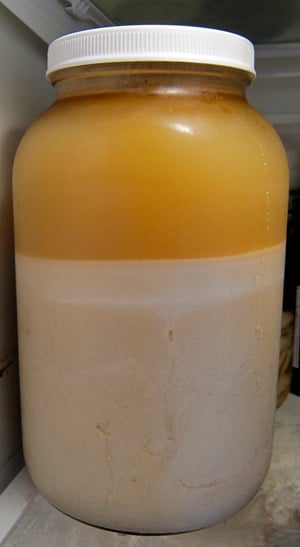
Put the jar into the fridge or just a cool place — it must be below 75°F or the flour will ferment — and walk away. Each morning, pour off the water, being careful to not lose too much of your acorn flour. Refill the jar, cap it and shake the hell out of it, turning it upside down to make sure all the acorn flour is suspended in the water. Repeat as necessary.
Now, there is an added tip you can do to make an even higher quality acorn flour: Strain the water every day through cheesecloth. Why? Look at the picture above: See the top layer that’s lighter in color? It’s acorn fat and starch.
It’s so light some will pour off every day as you change the water. Straining through cheesecloth preserves this fat and starch and will make your flour even richer and tastier. Do this and you will be rewarded with flavor later.
You know your acorn flour is ready when you roll some around in your mouth and it tastes really bland. Not tannic or bitter at all. Roasting can eliminate a little bit of tannin, but we’re not roasting in this case, so you want the flour to be as “clean” as possible.
For California Valley oak acorns, Eastern white oak acorns or other “sweet” acorns, this process could take as few as three days. But 5 days is more normal. California black and blue oaks take about a week. And Eastern red oak acorns? They took 10 days. When in doubt, go another day. You can’t hurt the flour by leaching a few extra days.
Now you have a bunch of soaking wet flour. First thing you will need is cheesecloth. Any supermarket will have it, but I have taken to using real cheesecloth, i.e., cloth actually used in cheesemaking. You can buy real cheesecloth online or in specialty shops.
Line a fine-mesh strainer with some cheesecloth and set it over the sink. Pour the water in the jar through it, catching all the flour.
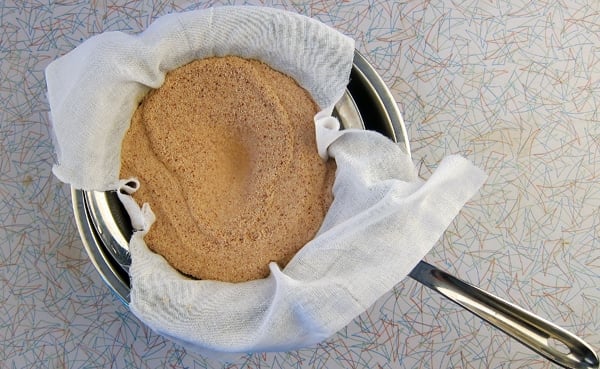
Squeeze the cloth tight around the flour to extract as much water as possible. This is why I use real cheesecloth — the cheap stuff at most supermarkets is too porous and thin to do the job very well, forcing you to squeeze less and spend more time drying — and the longer the drying time, the darker the flour. You will be left with what looks a lot like a ball of clay.
Tip: Let the water in the bowl settle for 1 hour. Carefully pour off the water and you will see a layer of what looks like beige house paint or melted coffee ice cream. This is acorn starch and fat. Use a spatula to scrape it into the container you are drying your acorns in.
Now you need to really dry your flour, unless you plan on making something with it right away. I almost never do this.
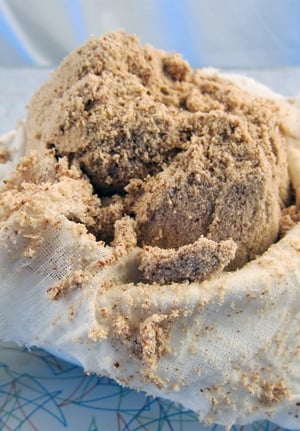
Spread your wet flour on a baking sheet, or on a solid dehydrator tray; the trays you use for fruit leather. I prefer the dehydrator because I can dry at a lower temperature. Or, if you do this in summer, you can dry outdoors or in a hot garage.
Dry at as low a temperature as you can. I use a dehydrator set at 95°F. Check in on your flour every few hours, turning it over so it dries evenly. This can take anywhere from an hour to a day. You want the flour to be dead dry. No moisture.
You are almost there. You now have what is essentially acorn “corn meal,” a gritty, coarse “flour” you can use to make polenta with; it’s pretty good, actually. But to make real flour you need to grind it one more time.
To turn your acorn polenta into acorn flour, grind the dried meal in a spice grinder, coffee grinder, or, best yet, a Vitamix fitted with dry blades. This is what I use, and it is worth every penny.
If you have a flour sifter this is a good time to break it out. Grind and sift into a clean bowl until you have nothing but pure, powdery goodness. A typical coffee grinder will require about 35 seconds of grinding to get there, my Vitamix takes only 15 seconds.
Your acorn flour is mildly fragile, especially if you are dealing with high fat acorns, like blue oaks, live oaks and red oaks. I store mine in quart Mason jars in the fridge or freezer. Stored this way, the flour will last for several years — which is good, because oaks don’t drop huge amounts of acorns every year.
Does all this sound like a lot of work? Well, I won’t lie to you: It is. And like I said, this process makes the highest quality acorn flour possible. There are easier ways, but the quality of the flour is inferior. This will make you quite aware about how we take regular wheat flour for granted. Do this and I can guarantee you will not be tossing around acorn flour the way you would with all-purpose. It’s too precious.
How to Make Acorn Flour
Equipment
- Cheesecloth
- A large jar
- Blender
Ingredients
- 3 pounds acorns
- Water
Instructions
- Start by shelling your acorns into a bowl of cool water. This will take about an hour, more or less. I typically do it while watching television. Putting the shells in water immediately will prevent them from oxidizing.
- Once you have all the acorn meats shelled (a little of the brown skin, called the test, is OK), puree them with water in the blender. Pour this into your large jar and set in a cool place, cooler than about 60°F. I will often refrigerate it. Temperatures too warm will cause it to ferment.
- Every day, up to twice a day, carefully pour off the water and replace it. As an added, but optional step, you can pour the last of each day's water -- the stuff with the most fine sediment in it -- into a baking sheet and let the water evaporate from it. What's left is pure acorn starch, which you can use exactly like corn starch.
- After about four or five days, taste the meal. It should be bland, not bitter. If it is still bitter, keep changing the water until it's not. Each species of acorn will need different leaching times.
- When the wet meal is ready, move it to a strainer lined with cheesecloth. Strain out as much water as possible. In this step, you really do want to capture this last water because it is loaded with starch. Let that water evaporate from a baking sheet.
- Lay out your wet acorn meal to dry. I use a dehydrator set at 95°F. Shoot for conditions like that. An oven is too hot and will turn the flour dark brown.
- When the meal is completely dry, add it and any chunks of acorn starch to a spice grinder or blender and buzz until completely fine, like wheat flour. Store in a jar in the fridge or freezer, so the acorn fats don't go rancid. It will keep this way a year or more.
Notes
Nutrition information is automatically calculated, so should only be used as an approximation.


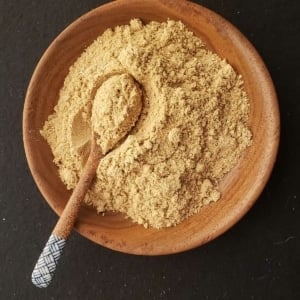




Thanks for the fast reply Hank!
Reading Hunt Gather Cook right now. Bought it for the tips on cooking ducks, but have been fascinated with the other foraging related ideas. What books do you recommend for plant and tree identification. I’m in Richmond Virginia if thats important to know.
Working on boiling some acorns right now!
Connor: I’d get the foraging books by Sam Thayer. They are the best for your area.
Whoa really happy to see your Blog and about the acorns! Have a new heartfelt respect for the acorn even more so now!
Hi Hank,
Thanks for the warning about the Buckeyes, much appreciated.
Hank,
Great write up, I’ll definitely be making acorn flour this year.
I have a question though, I recently ran into a pretty good growth of buckeyes. I know they have a lot of tannins, but native Americans used to roast and eat them. I would think the cold processing method as the acorns that you’ve written about would be a good start. Do you have some experience with Buckeyes? (I searched your website earlier but didn’t find anything.)
Much appreciated,
John
John: They did not really roast buckeyes. They soaked them in rivers to remove the prussic acid for days and days, pounded them into meal and suffered through it. This is the California buckeye. Midwestern buckeyes are inedible.
G’day Hank. Cool article and website. Only just discovered it. I’m in Australian, so our seasons are reversed compared to yours. with Autumn approaching I’m foraging everything from wild blackberries to feral apples and peaches. All the acorns are swelling on the tree at the moment, so got me thinking about there possible use.
I’m just wondering if picking the acorn ‘green’ odd the tree is a good idea? I’m thinking the tannins shouldn’t developed much yet, but has the kernal grown enough to harvest flour?
Your thoughts?
Jason: All depends on the variety. I generally don’t pick green, but I have with California black oaks, and it worked fine. But the tannins are very much there, so you are not getting around that by picking early.
I appreciate all your information you’ve shared. I still feel unclear about the process and there are still some unanswered questions in the protocol for processing acorns.
I live in Santa Cruz – we have an abundance of LIve Oaks – so that is the primary type of acorns, although we also have an abundance of Tan Oak.
Is this the order of the process?
Harvest healthy clean nuts.
Dry – how long is this drying process I’ve read 1-2 days 2- 3 weeks. I’ve read sun dry, oven dry on ?what temp?
Crack Open
– here is where I’m not clear – is it necessary to get the inner skin of the acorn off and how is this best done? I’ve read if nuts are dry it will come off easily. I’ve read boil them off, but then that seems to conflict with rest of process?
Immediately put peeled acorn in water to preserve color
Grind or Chop
Leach in cold or hot water depending on use – does hot water leaching compromise protein or fat value?
Grind more
Use
Thanks for your clarification on these questions. Palika
How can I find information on how to determine if an oak is “red” or “white”?
I have two types in my yard: Water Oaks (drops enormous amounts of acorns every other year) and Live Oaks.
Hello! I was interested in reading your “Acorns and the Forager’s Dilemma,” but the link always forwards me to this story. Could you reset the link?
Many thanks!
Claire: No. All that information is now in this post.
This year I picked about ten pounds of acorns. Some of my trees put out millions of ‘tiny’ virtually empties, but others are large enough to use. I wash and dry them in the shell and then dry them in the sun for a week or so and they shell easily. When they’re shelled I rough them up in a blender and cold leach them, straining them usually three or four times, then dry them again, then grind them. Someone gave me a few black oak acorns and three huge ones from Oregon Blue Oaks which I’m trying to grow and plant. Have Pomo friends who help me out . Really appreciate your site. thanks.
Don’t try to leach your acorns in the toilet tank, unless you don’t mind brown stains running down the sides of your bowl. Also the blackish water looks really gross to guests that might use your bathroom.
Hank,
The 2015 bow season has, so far, been a bust…. save for the copious amounts of available mast! So far I’ve collected over a pound of shucked white oak acorns. Can I leach them semi-whole, without grinding? Ultimately they will get ground as my intention is to make “acorn butter” and not use them as a flour per se.
Chris in Wisconsin
Chris: Sorry to hear about the deer season. Nope you need to at least chop the acorns roughly to leach them properly. If you leave them in large pieces they can take months to leach out.
I read somewhere that if you throw the fresh acorns in a bucket if water the wormy ones will float???? Thanks
Erica: For the most part, yes. But fresh acorns with worms that are just getting going will still sink.
I’d like to try tanoak acorns. Have you ever? just going by the name, I’d assume heavy tannins, but would it be worth the time and effort?
Dick: Yes, definitely worth the effort. What they have in tannin they trade for flavor.
I just read that avocado pits are edible, nutritious, but bitter. I wonder if the same process could be used on them?
This is my first attempt at making acorn flour and yes it is a lot of work. Getting ready to shell and then run the acorns through a grinder. I don’t have a food processor and my initial research lead me to purchase a corn grinder. Am making a mistake?
Barbara: A corn grinder should work.
The oak trees in my back yard have a bumper crop of acorns this year so I decided to try making the acorn flour. I picked about 1/2 gallon of nuts. Of that 1/2 gallon there were 7 acorns that didn’t have some sort of bug damage, larva, or eggs. By cutting out bug damage, I was able to come up with about 1/2 cup of meat. I avoided any nuts with obvious damage or holes, but can anyone suggest ways to know ahead of time which acorns are good?
Thanks
Brita: First off, oaks jettison bad acorns first, so early pickings are almost always rotten. Second, look for acorns that are heavy for their size and that have clean, caps where the “hat” used to be. Don’t pick up any with caps that look off. That should help a lot.
Hey Hank, two things. 1) I think your links here may be misdirected as the “Acorns and the forager’s dilemma” link takes you to the “Best way to make Acorn flour” page. But maybe this is intentional? 2) For a first time acorn flour attempt, how much acorns would you suggest harvesting to make a decent batch?
Thanks!
Goodness Betty do you realize that this was also a staple food for many native American people?
are we not taking food from the animals – this is their primary food source – not ours. your website is amazing, but a little sad – squirrels and other animals love acorns and we are harvesting their food, what is left for them.
Thanks
Betty
Betty: Uh…. do you have any notion about how many acorns drop off even one tree? A big Valley oak can drop 2,000 pounds. I have never known any forager who has even used 200 pounds. So fear not, there are MORE than enough for birds and deer and squirrels.